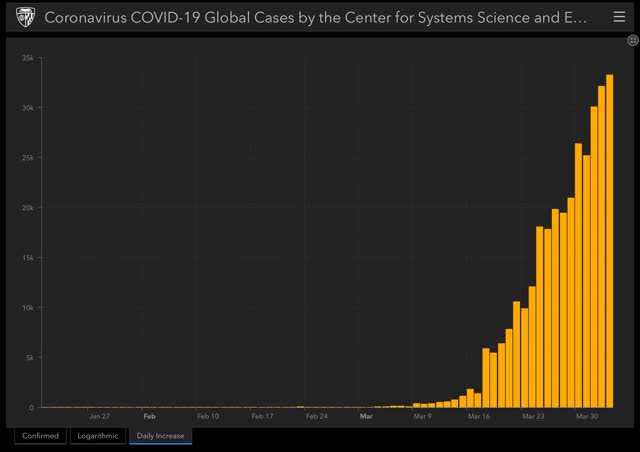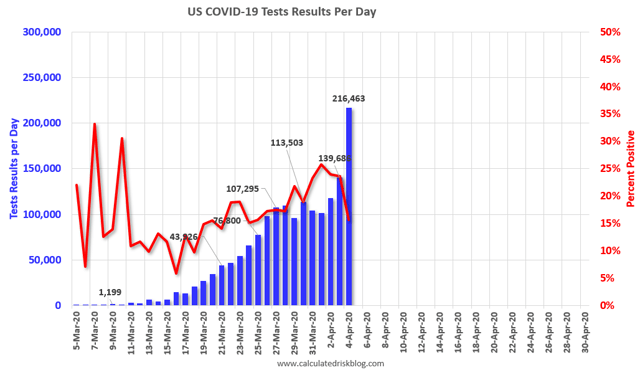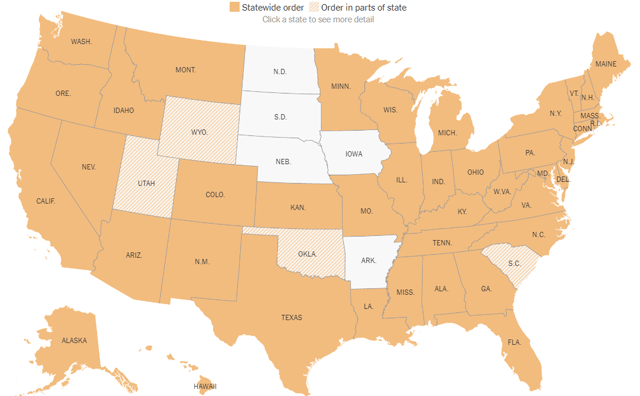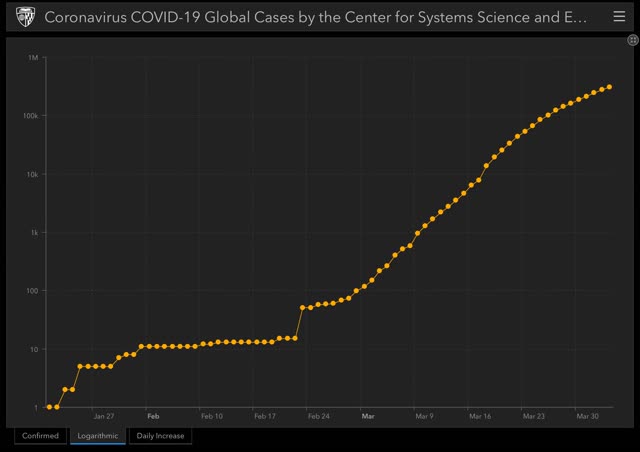Coronavirus dashboard for April 5: mandatory lockdowns start to work
Coronavirus dashboard for April 5: mandatory lockdowns start to work
by New Deal democrat
Here is the update through yesterday (April 4)
I’ve changed the format, moving the “just the facts, ma’am” data to the top, and comments to the end.
The four most important metrics are starred (***) below.
Number and rate of increase of Reported Infections (from Johns Hopkins via arcgis.com)
- Number: up +33,787 to 312,245 (vs. +32,857 on April 3)

- ***Rate of increase: day/day: 12% (vs. 34.6% baseline, 14% for the past week, and 13% on April 3)
The exponential growth rate began to fall on March 24. It now looks like in the past week or so it is in a new, decelerating trend, declining by about -1%/day. Voluntary social distancing was clearly not enough, but the State lockdowns appear to be beginning to work (more on that in a separate post).
- ***Number of deaths: Total 8,314, up +1,352 day/day
- Rate: increase of 19% day/day vs. average of 21% in past week
- Number of tests: 226,945, up +87,332 vs. 139,613 on April 3 day/day
- Rate: increase of +19% vs. number of tests previous day
- Tests pending result: 15,573 vs. 61,980 on April 3 day/day
Comparison of rates of increase in documented infections vs. testing
- Infections +19% vs. Tests +63% day/day
Result: The rate of testing had been failing to improve up until the past two days, meaning that we were actually falling further behind. Now we are catching up a little bit. Nevertheless, it remains far below what is needed, which is probably now at least 250,000/day. Note this target number is also increasing exponentially as we try to chase the number of exponentially increasing infections.
Ratio of tests to positives for infection (from COVID Tracking Project)
- Number: 226,945 new tests vs. 33,767 new diagnosed infections
- ***Ratio: 6.7:1

In South Korea, where aggressive testing has led to a near-total disappearance of new cases, the inflection point where the number of new daily cases plateaued was reached when the ratio of tests to new cases found reached 15:1. Any ratio less than that suggests that not enough testing is being done. Yesterday’s ratio of 6.7:1 is the best showing yet, but was *very* heavily influenced by the -45,000 decrease in “pending” tests.
US States and population in total lockdown, business lockdown, and partial restrictions
- ***Total lockdown: 42 States, 301.6 million, 90.9%
- ***Business lockdown: 3 States (KY, MA, SC*) 16.6 million, 5.0%
- Partial restrictions on business (bars, restaurants): 5 States (IA, ND, NE, UT*, WY^) 9.7 million, 2.9%
- School closure only: 2 States (AR^, SD) 3.9 million, 1.2%
- No mandatory restrictions: NONE
*some local areas under lockdowns
^restrictions on or quarantine of travelers from out of State

Following Trump’s reversal on Easter Sunday openings, most of the holdout States have implemented lockdowns. There have been no meaningful changes in the past day.
US States with “test, trace, and quarantine” programs
- Under development: 1 State: MA
- There were no meaningful changes today in governmental responses.
- Almost 95% of the total US population is – finally – under total lockdown, with only a few States in the Great Plains, plus Arkansas, Utah, and Wyoming holding out.
- While “Social distancing” and lockdowns appear to have lowered the growth rate of new infections, they have failed as a method to halt the virus’s spread.
- Mandatory lockdowns, first implemented on Statewide bases 16 days ago, appear to be making a difference.
- Travelers from States that resisted lockdowns until this week (especially Florida!) have probably re-seeded new outbreaks in those that went to lockdowns early. (This will be the subject of a separate post).
- The number of daily tests has finally improved from about 100,000 to 225,000, but is still short of of what is necessary, particularly since about 40,000 of that improvement was reducing the backlog of “Pending” tests.
- So long as the virus continues to spreading at an exponential rate, the longer it will be until total lockdowns can be lifted.
- The Trump Administration has still not mandated a nationwide lockdown.
- The Trump Administration has taken no meaningful steps to mandate mass production of necessary medical equipment.
- The Trump Administration has taken no steps towards a nationwide “test, trace, and quarantine” plan that will be needed to lift lockdowns.
- Massachusetts has begun to develop its own “test, trace, and quarantine” plan. Hopefully this will be adopted by other States quickly.


It appears the lockdown in GA made the situation there worse.
“Georgia Was Getting the Hang of Social Distancing. Then the Governor’s Shelter-in-Place Came Along.
“This feels like it might have been a middle finger to metro Atlanta’s stricter ordinances.”
Late last week, my Georgia friends and I rejoiced: Our governor, Brian Kemp, had finally issued a statewide shelter-in-place order to slow the spread of the coronavirus.
It was about time: A terrifying New York Times map showed that people in the Southeast hadn’t been staying home. Atlanta’s hospitals are now preparing for a “super surge” of COVID-19 patients. In Albany, a small city about 3 hours southwest of Atlanta, a single funeral spread the virus to more than 500 people. The local hospital has a total of 14 ICU beds.
At the press conference where he unveiled the order, Kemp said what all of us had been hoping he would finally say: Georgia can “win this war by hunkering down.”
But our relief was short-lived. On Friday night, just as the shelter-in-place was to take effect, the Atlanta Journal Constitution reported that under Kemp’s order, Georgia’s beaches, which had been closed by mayors in the coastal cities, had reopened. The statewide shelter-in-place mandated that beaches open for people seeking exercise—and the order superseded the local ordinances.
Like clockwork, on Saturday morning, the Savannah Morning News reported that beaches in the town of Tybee Island were filling up. Photos accompanying the piece showed people playing games on the beach, groups of a dozen or so people wading in the water, and crowds on the boardwalk. Saturday evening, the paper reported, a Tybee Island police officer tested positive for COVID-19.
Local leaders were livid. Later on Saturday, Tybee Island mayor Shirley Sessions closed beach parking lots and access points. Those small steps were all that the governor’s order allowed. Kemp, she told the Savannah Morning News, “holds all the cards. We hold none.”
The news about Georgia’s beaches reopening went national. But it wasn’t just Georgia’s coastal leaders who felt undermined by the loopholes in Kemp’s shelter-in-place. Late Friday evening, I got an email from Georgia state senator Sally Harrell, a Democrat who represents the suburbs just north of Atlanta in Georgia’s senate district 40. Georgia mayors, she told me, were dismayed to find that Kemp’s order undid the local social-distancing measures that they had worked hard to put in place. They learned, for example, that Kemp’s order prohibited local police from breaking up gatherings of more than 10 people.
On Saturday afternoon, I spoke with Stephe Koontz, a member of the city council of the suburb of Doraville. Kemp’s order, she said, “kind of threw our community into chaos. There’s been a lot of mixed messages because people are saying, ‘Well, I read the governor’s order and we know police can’t do anything right now, so we’re going to go ahead and have a party.’”
Koontz pointed out that most of the time, in Georgia, statewide laws are meant to serve as a baseline—if local communities want to make stricter rules, they’re free to do so. But Kemp’s shelter-in-place, said Koontz, is different: It forbids local leaders from enacting stricter social distancing laws. “In Georgia, usually the state law becomes the floor of the regulation, and in most cases the cities are allowed to be more restrictive,” she said. “But that’s not what he did.”
Sen. Harrell believes that Kemp’s shelter-in-place is a sneaky way of relaxing what the governor sees as local overreach. “Governor Kemp was very clear in delaying his own action, that he wanted local communities to take the lead—and they did,” she wrote to me in an email. “Then he came along and undid what they had done.” She added: “Kemp’s Shelter-in-Place order, by virtue of how it nullifies all local emergency ordinances, is clearly an attempt to walk back more stringent and conflicting local orders.”
Every day since January 20, 2017, the GOP has attacked the people of the United States. In a country not polarized by racial attitudes, they would never win another election.
Very sad.
“The Trump Administration has still not mandated a nationwide lockdown.
The Trump Administration has taken no meaningful steps to mandate mass production of necessary medical equipment.
The Trump Administration has taken no steps towards a nationwide “test, trace, and quarantine” plan that will be needed to lift lockdowns.
Massachusetts has begun to develop its own “test, trace, and quarantine” plan. Hopefully this will be adopted by other States quickly.”
I do not want the Trump Administration to use the same types dis-empowering orders that the Georgia governor issued when conducting any of this (I hope Georgia citizens defend themselves in terms of equal protections and public health and safety and sever those aspects of their Governor that are intended to serve political positioning rather than public health and safety.
I also would expect adjacent States to voice complaints and defend their borders so Georgians understand how to work in a coordinated way here. I would prefer that the States work this out. The federal government should provide fiscal and practical support. I would be fearful of placing all the roll outs of test/trace, credentialing of places and people as immune, and the decisions of who and what places can restart work practices to the Trump administration with the powers of a mandate.
Fortunately the President and the national government cannot MANDATE public health and safety rules as if they have the polis power, as the States and people hold (but did not grant to the new federal government).
Please media and writers of this article stop implying that the President can do this. I do not want an unfettered, empowered Trump Administration.
I would not trust Trump with lockdowns either. His only real job was to provide the production needed and of course he failed(and committed treason on that at the same time with the masks).
Once social distancing/stay at home orders ends COVID-19 transmission rates will return to normal, and the epidemic will proceed largely as it would have without mitigations, unless a significant fraction of the population is immune (either because they have recovered from the infection or because an effective vaccine has been developed), or the infectious agent has been completely eliminated.